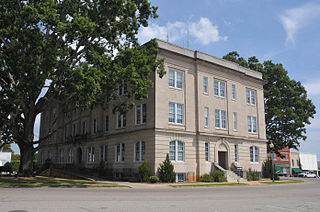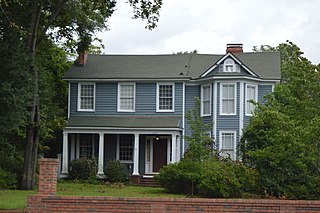
Carthage is the county seat of Moore County, North Carolina, United States. The population was 2,635 at the 2020 census. The city is named after Carthage.

The Paul Revere House, built c.1680, was the colonial home of American Patriot and Founding Father Paul Revere during the time of the American Revolution. A National Historic Landmark since 1961, it is located at 19 North Square, Boston, Massachusetts, in the city's North End, and is now operated as a nonprofit museum by the Paul Revere Memorial Association. An admission fee is charged.
Alston-DeGraffenried Plantation or Alston-DeGraffenried House is a historic property located in Chatham County, North Carolina, near Pittsboro, North Carolina. It includes a plantation house built through the forced labor of at least 11 enslaved people between about 1810 and 1825, and its surrounding agricultural fields. The property was first listed on the National Register of Historic Places in 1974 and the listed area was increased in 1993. The house and the surrounding land are identified as a national historic district.
McLean House may refer to:

Red Banks Primitive Baptist Church is a historic Primitive Baptist church located between Meeting House Branch and E. Firetower Road in Greenville, Pitt County, North Carolina. The original church building was set on fire on December 30, 1863, by Union forces under the command of Col. Joseph M. McChesney. It was rebuilt in 1893 and is a one-story, frame, gable front, rectangular, building measuring approximately 50 feet by 30 feet. It is two bays wide and five bays deep and sits on a brick pier foundation. Located on the property is the contributing church cemetery with less than 20 markers.

Quaker Meadows, also known as the McDowell House at Quaker Meadows, is a historic plantation house located near Morganton, Burke County, North Carolina. It was built about 1812, and is a two-story, four bay by two bay, Quaker plan brick structure in the Federal style. It features two one-story shed porches supported by square pillars ornamented by scroll sawn brackets. The Quaker Meadows plantation was the home of Revolutionary War figure, Col. Charles McDowell. It was at Quaker Meadows that Zebulon Baird Vance married Charles McDowell's niece, Harriet N. Espy.

Dr. Joseph Bennett Riddle House is a historic home located at Morganton, Burke County, North Carolina. It was built about 1892, and is a 2+1⁄2-story, five-bay, Queen Anne style frame house. It features a number of balconies, bay windows, and dormers. A three-story tower was added in about 1910.

Henry McLean House is a historic home located at Fayetteville, Cumberland County, North Carolina. The original section was built about 1840, and is a two-story, side-hall plan, vernacular Greek Revival style frame dwelling. A Victorian style two-story, four room wing was added between about 1875 and 1880. Additional rooms were added in the early-20th century.

Dr. William C. Verdery House is a historic home located at Fayetteville, Cumberland County, North Carolina. It was built in 1936, and is a Colonial Revival-style brick dwelling. It consists of a two-story, main block flanked by a two-story wing and a one-story porch wing on the west and a one-story wing and recessed two-bay wing on the east. It is topped by a slate gable roof and features an Ionic order entrance surround.
McClelland-Davis House is a historic home located near Statesville, Iredell County, North Carolina. The house was built about 1830, and is a two-story, five bay by two bay, transitional Federal / Greek Revival style frame dwelling. It has a gable roof, one-story rear wing, and two single shoulder brick end chimneys. Also on the property are the contributing smokehouse and well house.
Farmville Plantation is a historic plantation house located near the historic location, called Elmwood south of Statesville in Iredell County, North Carolina. It consists of two Federal style houses. The main house was built about 1818, and is a two-story, three bay by two bay, brick dwelling with a two-story entrance portico. The house is also known as the Joseph Chambers house or Darshana. The main house has a low gable roof and one-story rear shed porch. Attached to it by a breezeway is a smaller two-story, three bay by two bay stuccoed brick dwelling. The house was restored in the 1960s.
The Gen. Joseph Arrington House is a historic plantation house located near Hilliardston, Nash County, North Carolina.
Dr. Hassell Brantley House is a historic home located at Spring Hope, Nash County, North Carolina. It was built in 1912, and consists of a two-story, five-bay, central block with two-story gable roofed wings. A has a one-story rear kitchen wing with a hip roof. The front facade features full-height, Classical Revival pedimented portico, with Ionic order columns and a wrap-around porch.

Green River Plantation is a historic plantation house on over 360 acres located near Columbus, Polk County, North Carolina. The oldest section of the "Big House" was built between the years 1804–1807, and is a two-story, four-bay, Late Federal style frame dwelling. A later two-story, four-bay, brick Greek Revival style dwelling was built beside the original structure in the mid-19th century. The two sections were joined in the late 19th century by a two-story section and grand staircase to form a structure that is over 10,000 square feet in size and boasts over 42 rooms and spaces. The plantation house was built by Joseph McDowell Carson, son of Col. John Carson, who built Carson House at Marion, North Carolina. The later-built section of the home was the residence of Samuel Price Carson, North Carolina State Senator and U.S. Federal Representative, and younger brother of Joseph McDowell Carson.

Stewart-Hawley-Malloy House is a historic home located near Laurinburg, Scotland County, North Carolina. It was built about 1800, and is a transitional Georgian / Federal style frame dwelling. It consists of a two-story, five bay by two bay, main block with a one-story, two bay by four bay, wing. The main block has a full-width, one-story front porch and rear shed additions. It was built by North Carolina politician James Stewart (1775-1821) and the birthplace of Connecticut politician Joseph Roswell Hawley (1826-1905).

Dr. Hubert Benbury Haywood House is a historic home located at Raleigh, Wake County, North Carolina. It was built in 1916, and is a two-story, Prairie School-style brick dwelling with a green tile hipped roof and two-bay wide, one-bay deep, one-story brick sun porch. A two-story rear ell was added in 1928. The interior has Colonial Revival style design elements.
Little Manor, also known as Mosby Hall, is a historic plantation house located in Warren County, North Carolina near the town of Littleton. It was built about 1804, and is a Federal style frame dwelling consisting of a two-story, five-bay, pedimented main block flanked by one-story wings. It has a pedimented center bay front porch with Doric order pilasters and an older two-story rear wing, dated to about 1780.
Joseph John Pender House is a historic plantation house located near Wilson, Wilson County, North Carolina. The original section of the house was built about 1840 by Joseph John Pender, a large landowner and successful planter who was a member of a prominent landholding family. The house consists of a two-story, three bay, Federal frame section and a one-story frame kitchen/dining room ell. Also on the property are the contributing frame well structure and two tobacco barns.
Dr. H. D. Lucas House was a historic home located at Black Creek, Wilson County, North Carolina. It consisted of two sections: a one-story Greek Revival style doctor's office built about 1850, and a late-19th century, Victorian cottage dated to the early 1880s, which served as Dr. Lucas' residence. The cottage was a one-story, three-bay, single-pile frame dwelling with a steeply pitched gable roof. The house has been demolished.














